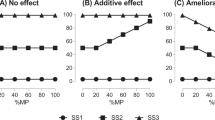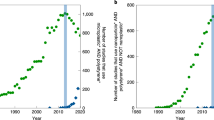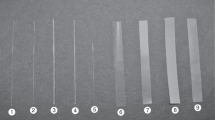Abstract
Despite the increasing concern about the harmful effects of micro- and nanoplastics (MNPs), there are no harmonized guidelines or protocols yet available for MNP ecotoxicity testing. Current ecotoxicity studies often use commercial spherical particles as models for MNPs, but in nature, MNPs occur in variable shapes, sizes and chemical compositions. Moreover, protocols developed for chemicals that dissolve or form stable dispersions are currently used for assessing the ecotoxicity of MNPs. Plastic particles, however, do not dissolve and also show dynamic behavior in the exposure medium, depending on, for example, MNP physicochemical properties and the medium’s conditions such as pH and ionic strength. Here we describe an exposure protocol that considers the particle-specific properties of MNPs and their dynamic behavior in exposure systems. Procedure 1 describes the top-down production of more realistic MNPs as representative of MNPs in nature and particle characterization (e.g., using thermal extraction desorption-gas chromatography/mass spectrometry). Then, we describe exposure system development for short- and long-term toxicity tests for soil (Procedure 2) and aquatic (Procedure 3) organisms. Procedures 2 and 3 explain how to modify existing ecotoxicity guidelines for chemicals to target testing MNPs in selected exposure systems. We show some examples that were used to develop the protocol to test, for example, MNP toxicity in marine rotifers, freshwater mussels, daphnids and earthworms. The present protocol takes between 24 h and 2 months, depending on the test of interest and can be applied by students, academics, environmental risk assessors and industries.
Key points
-
In nature, micro- and nanoplastics (MNPs) occur in various shapes, sizes and chemical compositions. Each of these properties can affect both their dynamic behavior and their toxicology and should be considered when performing ecotoxicology experiments to assess their risk.
-
Here, MNPs are generated from plastic waste by using either a ball or centrifugal mill. Their physicochemical properties are measured. Ecotoxicology experiments in soil and aquatic systems are described.
This is a preview of subscription content, access via your institution
Access options
Access Nature and 54 other Nature Portfolio journals
Get Nature+, our best-value online-access subscription
$29.99 / 30 days
cancel any time
Subscribe to this journal
Receive 12 print issues and online access
$259.00 per year
only $21.58 per issue
Buy this article
- Purchase on Springer Link
- Instant access to full article PDF
Prices may be subject to local taxes which are calculated during checkout







Similar content being viewed by others
References
Persson, L. et al. Outside the safe operating space of the planetary boundary for novel entities. Environ. Sci. Technol. 56, 1510–1521 (2022).
MacLeod, M., Arp, H. P. H., Tekman, M. B. & Jahnke, A. The global threat from plastic pollution. Science 373, 61–65 (2021).
Gigault, J. et al. Nanoplastics are neither microplastics nor engineered nanoparticles. Nat. Nanotechnol. 16, 501–507 (2021).
Abdolahpur Monikh, F. et al. Can current regulations account for intentionally produced nanoplastics? Environ. Sci. Technol. 56, 3836–3839 (2022).
Alimi, O. S. et al. Weathering pathways and protocols for environmentally relevant microplastics and nanoplastics: what are we missing? J. Hazard. Mater. 423, 126955 (2022).
A Scientific Perspective on Microplastics in Nature and Society. Evidence Review Report (Science Advice for Policy by European Academies, 2019); https://sapea.info/topic/microplastics/
Rochman, C. M. et al. Policy: classify plastic waste as hazardous. Nature 494, 169–170 (2013).
Browne, M. A., Niven, S. J., Galloway, T. S., Rowland, S. J. & Thompson, R. C. Microplastic moves pollutants and additives to worms, reducing functions linked to health and biodiversity. Curr. Biol. 23, 2388–2392 (2013).
Wang, W., Ge, J. & Yu, X. Bioavailability and toxicity of microplastics to fish species: a review. Ecotoxicol. Environ. Saf. 189, 109913 (2020).
Jovanović, B. Ingestion of microplastics by fish and its potential consequences from a physical perspective. Integr. Environ. Assess. Manag. 13, 510–515 (2017).
Huuskonen, H. et al. Do whitefish (Coregonus lavaretus) larvae show adaptive variation in the avoidance of microplastic ingestion? Environ. Pollut. 262, 114353 (2020).
Arias-Andres, M., Klümper, U., Rojas-Jimenez, K. & Grossart, H. P. Microplastic pollution increases gene exchange in aquatic ecosystems. Environ. Pollut. 237, 253–261 (2018).
Arias-Andres, M., Kettner, M. T., Miki, T. & Grossart, H. P. Microplastics: new substrates for heterotrophic activity contribute to altering organic matter cycles in aquatic ecosystems. Sci. Total Environ. 635, 1152–1159 (2018).
Abdolahpur Monikh, F. et al. Chemical composition and particle size influence the toxicity of nanoscale plastic debris and their co-occurring benzo(α)pyrene in the model aquatic organisms Daphnia magna and Danio rerio. NanoImpact 25, 100382 (2022).
El Hadri, H., Gigault, J., Maxit, B., Grassl, B. & Reynaud, S. Nanoplastic from mechanically degraded primary and secondary microplastics for environmental assessments. NanoImpact 17, 100206 (2020).
EFSA CONTAM Panel (EFSA Panel on Contaminants in the Food Chain). Presence of microplastics and nanoplastics in food, with particular focus on seafood. EFSA J. 14, 4501 (2016).
Abdolahpur Monikh, F. et al. The analytical quest for sub-micron plastics in biological matrices. Nano Today 41, 101296 (2021).
Xia, B. et al. Secondary PVC microplastics are more toxic than primary PVC microplastics to Oryzias melastigma embryos. J. Hazard. Mater. 424, 127421 (2022).
Yin, K. et al. A comparative review of microplastics and nanoplastics: toxicity hazards on digestive, reproductive and nervous system. Sci. Total Environ. 774, 145758 (2021).
Abdolahpur Monikh, F. et al. Particle number-based trophic transfer of gold nanomaterials in an aquatic food chain. Nat. Commun. 12, 899 (2021).
Jeong, C.-B. et al. Microplastic size-dependent toxicity, oxidative stress induction, and p-JNK and p-p38 activation in the monogonont rotifer (Brachionus koreanus). Environ. Sci. Technol. 50, 8849–8857 (2016).
Abdelsaleheen, O. et al. The joint adverse effects of aged nanoscale plastic debris and their co-occurring benzo[α]pyrene in freshwater mussel (Anodonta anatina). Sci. Total Environ. 798, 149196 (2021).
Abdolahpur Monikh, F., Chupani, L., Vijver, M. G. & Peijnenburg, W. J. G. M. Parental and trophic transfer of nanoscale plastic debris in an assembled aquatic food chain as a function of particle size. Environ. Pollut. 269, 116066 (2021).
Kokalj, A. J., Hartmann, N. B., Drobne, D., Potthoff, A. & Kühnel, D. Quality of nanoplastics and microplastics ecotoxicity studies: refining quality criteria for nanomaterial studies. J. Hazard. Mater. 415, 125751 (2021).
Guidance Document on Aquatic and Sediment Toxicological Testing of Nanomaterials (OECD, 2022); https://one.oecd.org/document/env/jm/mono(2020)8/en/pdf
Abdolahpur Monikh, F., Doornhein, N., Romeijn, S., Vijver, M. G. & Peijnenburg, W. J. G. M. Method for extraction of nanoscale plastic debris from soil. Anal. Methods 13, 1576–1583 (2021).
Sobhani, Z. et al. Identification and visualisation of microplastics/nanoplastics by Raman imaging (i): down to 100 nm. Water Res. 174, 115658 (2020).
Ivleva, N. P. Chemical analysis of microplastics and nanoplastics: challenges, advanced methods, and perspectives. Chem. Rev. 121, 11886–11936 (2021).
Altmann, K. et al. Identification of microplastic pathways within a typical European urban wastewater system. Appl. Res. e202200078 (2023).
Horton, A. A. et al. Semi-automated analysis of microplastics in complex wastewater samples. Environ. Pollut. 268, 115841 (2021).
Radford, F. et al. Developing a systematic method for extraction of microplastics in soils. Anal. Methods 13, 1695–1705 (2021).
Smith, E. J., Davison, W. & Hamilton-Taylor, J. Methods for preparing synthetic freshwaters. Water Res. 36, 1286–1296 (2002).
Sugiyama, M., Wu, S., Hosoda, K., Mochizuki, A. & Hori, T. Method for the preparation of artificial lake and river waters. Limnol. Oceanogr. Methods 14, 343–357 (2016).
Tiwari, E. et al. Impact of nanoplastic debris on the stability and transport of metal oxide nanoparticles: role of varying soil solution chemistry. Chemosphere 308, 136091 (2022).
Guidance Document on Aquatic Toxicity Testing of Difficult Substances and Mixtures (OECD, 2019); https://www.oecd-ilibrary.org/environment/guidance-document-on-aquatic-toxicity-testing-of-difficult-substances-and-mixtures_0ed2f88e-en
Li, B. et al. Fish ingest microplastics unintentionally. Environ. Sci. Technol. 55, 10471–10479 (2021).
Nanninga, G. B. et al. Treatment-level impacts of microplastic exposure may be confounded by variation in individual-level responses in juvenile fish. J. Hazard. Mater. 416, 126059 (2021).
Xu, J. et al. Unpalatable plastic: efficient taste discrimination of microplastics in planktonic copepods. Environ. Sci. Technol. 56, 6455–6465 (2022).
Ma, C. et al. Application of internal persistent fluorescent fibers in tracking microplastics in vivo processes in aquatic organisms. J. Hazard. Mater. 401, 123336 (2021).
Franzellitti, S., Canesi, L., Auguste, M., Wathsala, R. H. G. R. & Fabbri, E. Microplastic exposure and effects in aquatic organisms: a physiological perspective. Environ. Toxicol. Pharmacol. 68, 37–51 (2019).
Abdolahpur Monikh, F., Vijver, M. G., Kortet, R., Lynch, I. & Peijnenburg, W. J. G. M. Emerging investigator series: perspectives on toxicokinetics of nanoscale plastic debris in organisms. Environ. Sci. Nano 9, 1566–1577 (2022).
Cowger, W. et al. Reporting guidelines to increase the reproducibility and comparability of research on microplastics. Appl. Spectrosc. 74, 1066–1077 (2020).
Luo, Y. et al. Quantitative tracing of uptake and transport of submicrometre plastics in crop plants using lanthanide chelates as a dual-functional tracer. Nat. Nanotechnol. 17, 424–431 (2022).
Abdolahpur Monikh, F. et al. An analytical workflow for dynamic characterization and quantification of metal-bearing nanomaterials in biological matrices. Nat. Protoc. 17, 1926–1952 (2022).
Skjolding, L. M., Kruse, S., Sørensen, S. N., Hjorth, R. & Baun, A. A small-scale setup for algal toxicity testing of nanomaterials and other difficult substances. J. Vis. Exp. https://doi.org/10.3791/61209 (2020).
Soil Quality—Effects of Pollutants on Earthworms (Eisenia fetida), Part 2: Determination of Effects on Reproduction, no. 11268-2 (ISO, 1998); https://www.iso.org/standard/20993.html
Hartmann, N. B. et al. The challenges of testing metal and metal oxide nanoparticles in algal bioassays: titanium dioxide and gold nanoparticles as case studies. Nanotoxicology 7, 1082–1094 (2013).
Petersen, E. J. et al. Adapting OECD aquatic toxicity tests for use with manufactured nanomaterials: key issues and consensus recommendations. Environ. Sci. Technol. 49, 9532–9547 (2015).
Ritz, C., Baty, F., Streibig, J. C. & Gerhard, D. Dose-response analysis using R. PLoS ONE 10, e0146021 (2015).
Xu, E. G. et al. Primary and secondary plastic particles exhibit limited acute toxicity but chronic effects on Daphnia magna. Environ. Sci. Technol. 54, 6859–6868 (2020).
Abdolahpur Monikh, F. et al. Quantifying the trophic transfer of sub-micron plastics in an assembled food chain. Nano Today 46, 101611 (2022).
Lahive, E. et al. Earthworms ingest microplastic fibres and nanoplastics with effects on egestion rate and long-term retention. Sci. Total Environ. 807, 151022 (2022).
Acknowledgements
This work received financial support from the UEF Water research program, which is jointly funded by the Saastamoinen Foundation, the Wihuri Foundation and the Olvi Foundation. The study was also partially funded by the European Union’s Horizon 2020 research and innovation program, via the projects PLASTICSFATE (Grant Agreement number 965367) and POLYRISK (Grant Agreement number 964766). N.T. acknowledges the Canada Research Chair program and the Killam Research Fellowship.
Author information
Authors and Affiliations
Contributions
F.A.M. designed the protocol, and conceptualized and supervised the protocol development. All the co-authors contributed to developing, writing, editing and reviewing the protocol.
Corresponding author
Ethics declarations
Competing interests
The authors declare no competing interests.
Peer review
Peer review information
Nature Protocols thanks Win Cowger and Xianfei Huang for their contribution to the peer review of this work.
Additional information
Publisher’s note Springer Nature remains neutral with regard to jurisdictional claims in published maps and institutional affiliations.
Related links
Key references using this protocol
Jeong, C.-B. et al. Environ. Sci. Technol. 50, 8849–8857 (2016): https://doi.org/10.1021/acs.est.6b01441
Abdelsaleheen, O. et al. Sci. Total Environ. 798, 149196 (2021): https://doi.org/10.1016/j.scitotenv.2021.149196
Abdolahpur Monikh, F. et al. Nano Today 46, 101611 (2022): https://doi.org/10.1016/j.nantod.2022.101611
Xu, E. G. et al. Environ. Sci. Technol. 54, 6859–6868 (2020): https://doi.org/10.1021/acs.est.0c00245
Altmann, K. et al. Appl. Res. e202200078 (2023): https://doi.org/10.1002/appl.202200078
Supplementary information
Supplementary Information
Supplementary Table 1
Rights and permissions
Springer Nature or its licensor (e.g. a society or other partner) holds exclusive rights to this article under a publishing agreement with the author(s) or other rightsholder(s); author self-archiving of the accepted manuscript version of this article is solely governed by the terms of such publishing agreement and applicable law.
About this article
Cite this article
Abdolahpur Monikh, F., Baun, A., Hartmann, N.B. et al. Exposure protocol for ecotoxicity testing of microplastics and nanoplastics. Nat Protoc 18, 3534–3564 (2023). https://doi.org/10.1038/s41596-023-00886-9
Received:
Accepted:
Published:
Issue Date:
DOI: https://doi.org/10.1038/s41596-023-00886-9
Comments
By submitting a comment you agree to abide by our Terms and Community Guidelines. If you find something abusive or that does not comply with our terms or guidelines please flag it as inappropriate.



